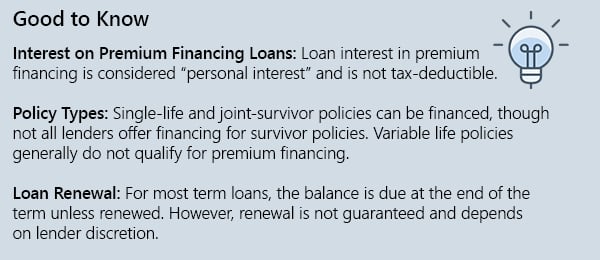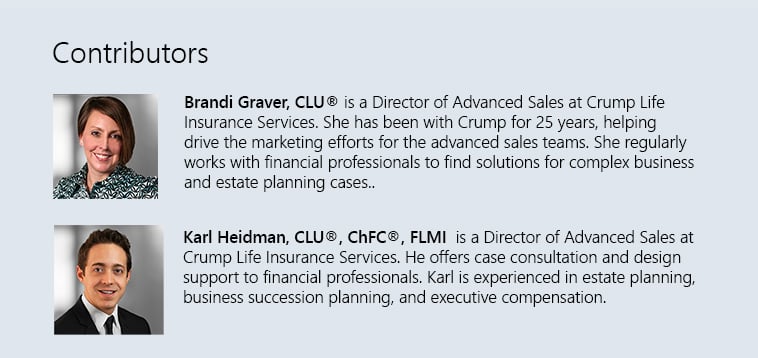Imagine taking out a loan not to buy a house, a car, or a business—but to fund your future legacy. In today’s world, borrowing isn’t just about acquiring tangible assets. For high-net-worth individuals, it’s an opportunity to leverage their financial power to preserve wealth for generations.
Premium financing can be an ideal tool for securing life insurance coverage without liquidating assets to generate the cash to pay premiums. This strategy allows savvy clients to keep their portfolios invested while tax-efficiently funding their estate plans.
What is Premium Financing?
Premium financing is a unique tool available to clients who recognize the need for life insurance in their estate plans but prefer to keep high-performing assets invested or wish to minimize gift taxes. By borrowing from a third-party lender, clients can avoid liquidating assets to pay premiums. In today’s economic climate, where asset preservation is critical, premium financing offers a powerful alternative that lets clients retain cash flow while securing life insurance for their estates.
Typically, clients borrow at a reasonable interest rate, using the life insurance policy—and additional collateral—as security for the loan. Many choose indexed universal life (IUL) and whole life (WL) policies because they offer potential cash value growth, which might be leveraged later to offset some portion of the loan principal and other costs. IUL and WL policies provide a death benefit and can, if structured carefully, serve as a tax-efficient asset over time, offering growth potential with downside protection.

Why Premium Financing Works in Today’s Market
In times of economic and political uncertainty, premium financing offers two unique advantages: the ability to preserve cash flow and the flexibility to take advantage of market movements without selling assets. This strategy can help clients navigate market challenges by allowing them to protect their portfolios while still ensuring their legacy plans are well-funded.
Clients may be hesitant to liquidate investments with large gains that would create significant taxable income. Premium financing provides an alternative: clients borrow at a manageable rate, minimizing the need to recognize taxable gains and allowing them to keep their portfolios intact for potential future growth. For clients with significant net worth, premium financing enables a “buy low” approach, allowing them to invest cash flow in their high-performing assets.
Ideal Client Profile for Premium Financing
Suitable clients for premium financing recognize the need for life insurance protection and seek coverage without disturbing their investment portfolios. Typically, these clients:
- Have a minimum net worth of $10 million
- Seek to preserve cash flow while securing life insurance for estate or business purposes
- Are willing to pledge additional collateral, which lenders often require
Ideal clients include successful business owners, real estate investors, or individuals anticipating a liquidity event (such as an inheritance or business sale). Premium financing allows them to secure significant life insurance coverage while leveraging existing assets.
However, clients relying primarily on illiquid assets, or those with insufficient collateral, may face challenges in qualifying. Financial professionals should assess the complete financial picture to ensure premium financing is suitable.

Understanding the Risks and Considerations
While premium financing offers compelling benefits, clients must understand the potential risks involved. Loan interest rates fluctuate and many financing structures use variable rates that will change annually. Additionally, the policy’s cash value might underperform, requiring more collateral than initially anticipated. If collateral or policy assets underperform, clients might face pressure to repay the loan or risk the policy lapsing. Financial professionals should ensure clients fully understand the financing structure and maintain regular reviews to monitor performance, adjusting to mitigate these risks.
Premium financing isn’t “free insurance.” By working with an experienced, trusted financing vendor and knowledgeable financial professional, clients can avoid potential misrepresentations in policy illustrations or projections that “look too good to be true.” This partnership ensures transparency, aligning the client’s expectations with a well-structured and sustainable financing plan.
Client Showcase
An ultra high-net-worth business owner sought premium financing to fund life insurance premiums for estate planning and business protection. Already owning several large life insurance policies, he wanted to avoid liquidating high-performing assets to cover new premium costs.
Discovery and Solution: Working with a team of financial professionals, the client purchased a $20 million policy funded through a 10-year premium financing arrangement. Using a mix of securities as collateral, he preserved cash flow, managed tax consequences, and minimized gift tax exposure. The collaborative approach between his advisors and insurance specialists ensured a tailored solution aligned with his goals.

Planning for the Exit Strategy
Successful premium financing plans include a defined strategy for repaying the loan, whether through the policy’s cash value, a liquidity event, or other assets. Waiting until death to repay the lender is not a viable exit strategy. Financial professionals should work with clients to establish an “exit” timeline that avoids future financial strain and supports long-term financial security.
Annual check-ups are essential to align the financing structure with the client’s goals and market conditions. Regularly reviewing interest rates, policy values, and collateral needs helps clients stay on track and adjust strategies to account for economic changes.
Premium Financing Process Flow
For high-net-worth individuals, premium financing is often owned through an irrevocable life insurance trust (ILIT) to shield the policy from estate taxes. The typical process includes these steps:
- Identify Need for Life Insurance
Client: Identifies the need for a large life insurance policy as part of estate or business planning - Policy Structure and Ownership
ILIT: Applies for life insurance to ensure the policy remains protected as part of the estate plan - Apply for Premium Financing
Lender: Reviews the policy loan application to ensure the client has sufficient assets to proceed - Loan Approval and Collateral Assignment
Lender and Client: The lender approves the loan, and the client provides collateral as security - Premium Payment to Insurance Carrier
Lender: Pays premiums directly to the insurance carrier on behalf of the ILIT - Policy Growth and Loan Management
Lender and Client: The policy cash values grow, and the loan and collateral are monitored - Exit Strategy Options
ILIT: The trustee repays the loan from trust assets, client gifts, the policy cash values, or other sources
Bottom Line
Premium financing is a powerful estate planning tool for high-net-worth individuals seeking life insurance without disrupting their investment strategies. However, this approach requires thoughtful planning, a clear understanding of potential risks, and ongoing monitoring. The clients should understand that financed insurance is not free, and using this method to pay for life insurance may expose them to additional risks not associated with traditional life insurance policy purchases. Those
additional risks include fluctuations in the loan interest rate, fluctuations in the policy crediting rate, fluctuations in future policy cash values, the potential need for additional collateral held outside the policy, and the potential gift tax exposure if the insured is forced to repay the loan on behalf of an ILIT (or some other individual or entity who is the policy owner).
For financial professionals, offering premium financing to suitable clients builds stronger relationships and supports long-term wealth goals. By leveraging borrowed capital to purchase life insurance, your clients can protect their legacies, support their businesses, and strategically deploy assets for their best uses.
